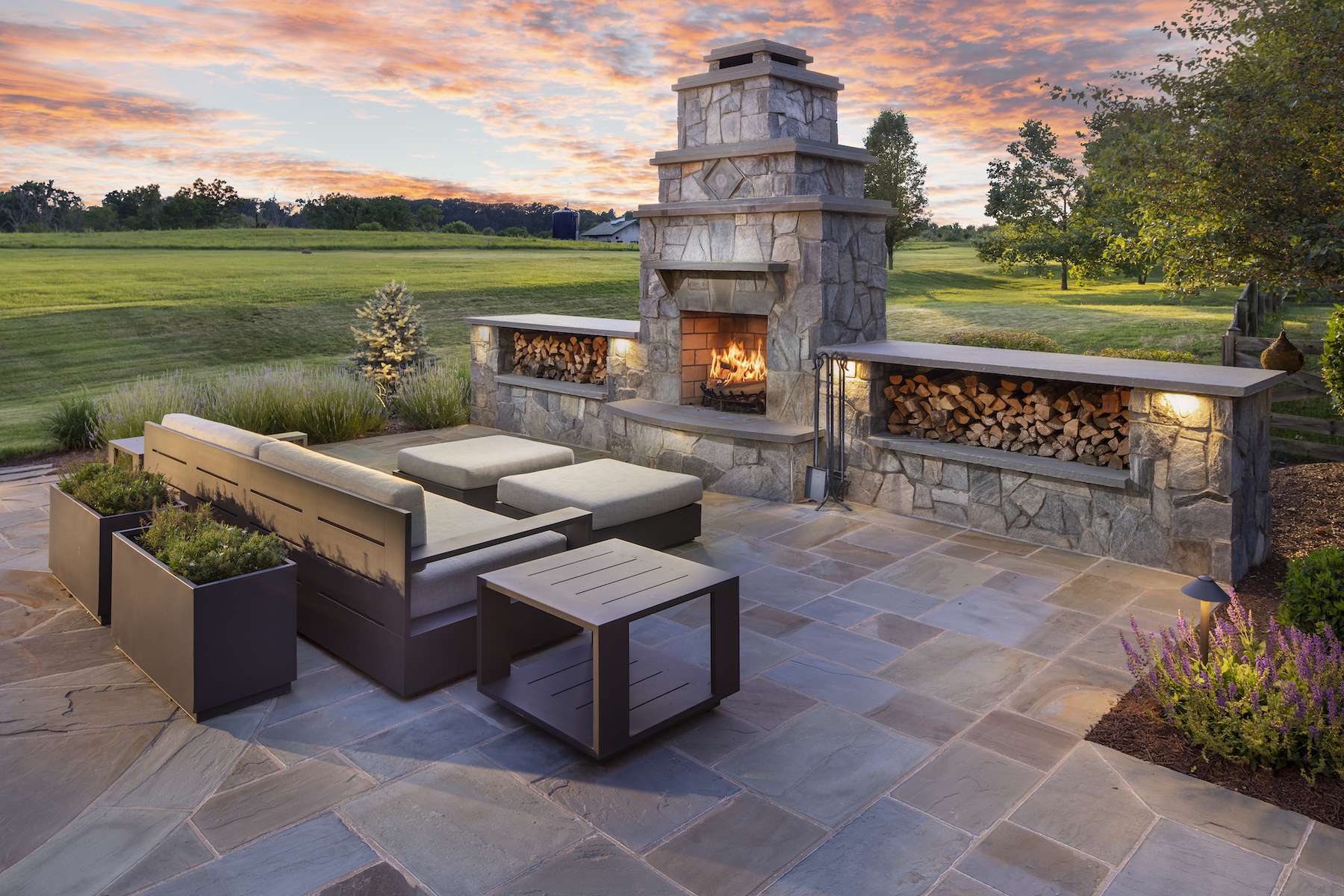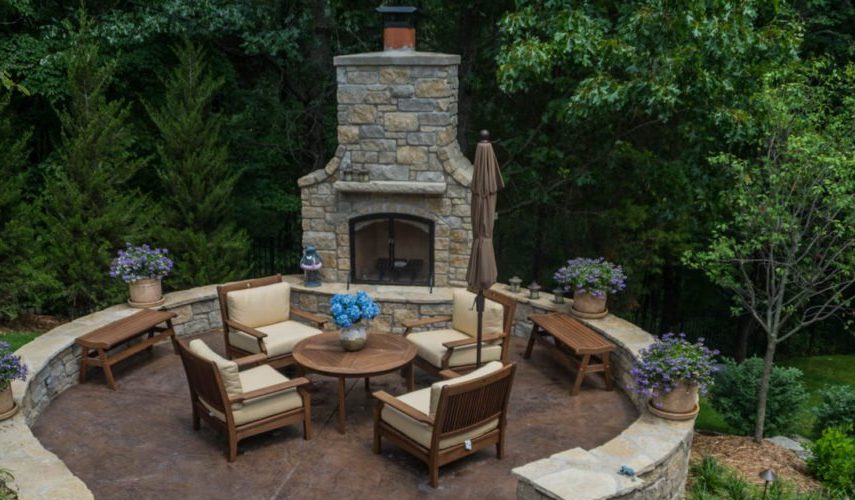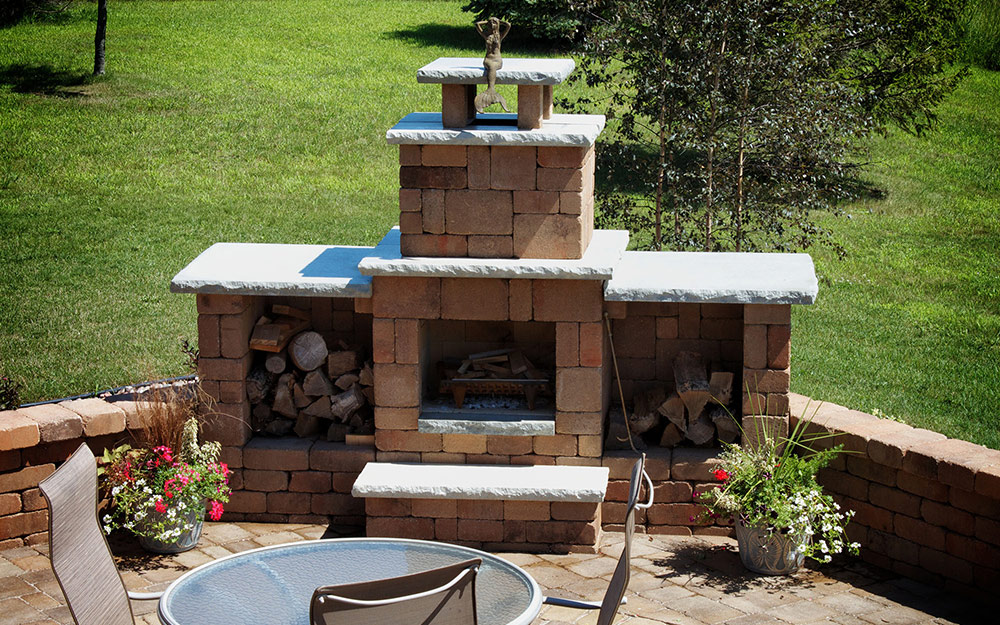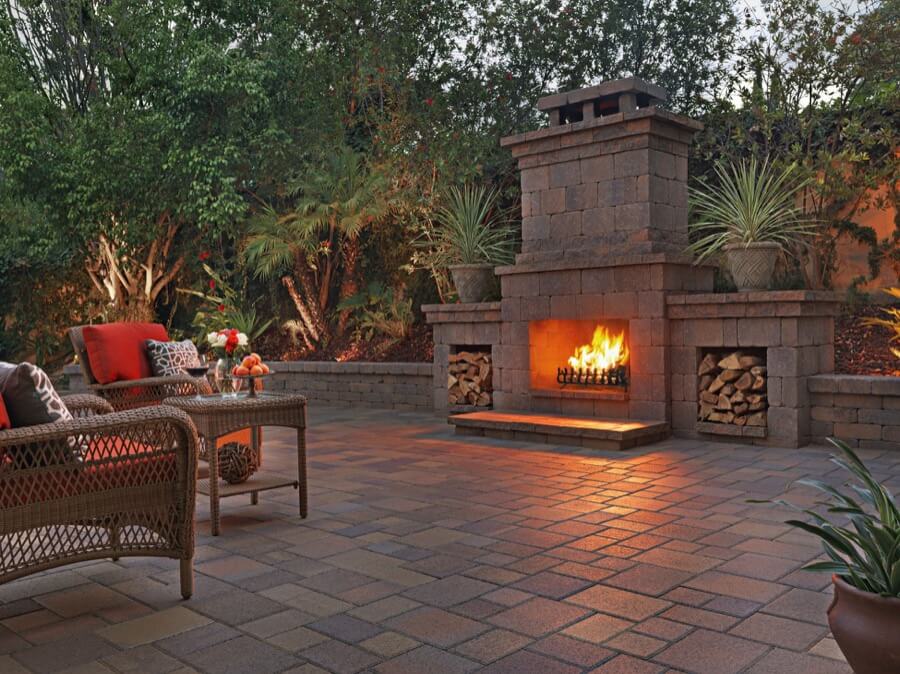An outdoor fireplace transforms your patio into a year-round gathering space, providing warmth, ambiance, and a natural focal point for entertaining. These structures range from simple fire pits to elaborate masonry masterpieces, each offering unique benefits for different spaces and lifestyles. Whether you want a cozy nook for intimate conversations or a showstopping centerpiece for large gatherings, the right outdoor fireplace elevates your patio’s functionality and style. Below are popular fireplace materials, innovative design concepts, space-saving solutions, cooking-friendly options, weather protection ideas, and budget-conscious approaches to help you create your perfect outdoor retreat.
Popular Materials for Patio Fireplaces
Natural stone remains a top choice for outdoor fireplaces, offering timeless beauty and excellent durability. Fieldstone, limestone, and granite create rustic charm that blends seamlessly with garden settings, while cut stone provides a more refined appearance. Stone’s thermal mass absorbs heat during the day and radiates it slowly at night, extending your patio’s comfortable use into cooler evenings. The material’s natural variations ensure each fireplace has a unique character, though professional installation is recommended for structural integrity.
Concrete fireplace surrounds offer modern appeal with nearly unlimited design flexibility. Poured concrete can be formed into curved, angular, or geometric shapes that would be difficult with other materials. Stamped or stained concrete mimics pricier stone at a fraction of the cost. Precast concrete fireplace kits simplify installation while providing a high-end look. Concrete’s smooth surfaces work particularly well with contemporary patio designs, and the material withstands harsh weather conditions with minimal maintenance beyond occasional sealing.
For those seeking warmth without permanent construction, metal fireplaces provide portable solutions. Powder-coated steel units resist rust while offering sleek, minimalist designs. Copper fireplaces develop a beautiful patina over time, adding vintage character to traditional patios. Cast iron models retain heat exceptionally well but require more maintenance to prevent rust. Metal fireplaces often incorporate mesh screens or glass doors for safety and spark containment. Many feature wheels or lightweight designs that allow repositioning as your patio layout evolves.
Design Concepts for Different Patio Styles
Mediterranean-inspired fireplaces create old-world charm with curved arches, terra cotta finishes, and decorative tile accents. These typically feature wide hearths for seating and may include built-in wood storage niches. Complement them with wrought iron furniture, colorful textiles, and potted olive trees for a cohesive look. The warm tones of stucco or limestone harmonize beautifully with Mediterranean color palettes of ochre, blue, and terra cotta. Consider adding a chimney pot or decorative cap for authentic detailing.
Modern minimalist designs focus on clean lines and simple geometric forms. Rectangular fireboxes with smooth concrete or metal surrounds create dramatic focal points without visual clutter. Many contemporary fireplaces incorporate negative space or floating hearths for lightness. Linear gas burners produce sleek ribbons of flame that align with modern aesthetics. Pair these with monochromatic patio furniture and architectural plantings for a cohesive look. Integrated lighting can highlight the fireplace’s form while providing practical illumination for evening use.
Rustic farmhouse fireplaces emphasize natural materials and handmade charm. Stacked stone or reclaimed brick constructions with wood beam mantels create cozy gathering spots. These often include wide hearths for seating and may incorporate hooks for hanging cooking tools. Mixing materials like stone and rough-sawn wood enhances the organic feel. Add vintage lanterns, wool throws, and galvanized metal accents to complete the look. A rustic fireplace becomes the heart of the patio, encouraging long conversations and relaxed gatherings.

Space-Saving Solutions for Small Patios
Corner fireplaces maximize limited square footage by utilizing often-wasted space. Triangular or curved designs tuck neatly into patio corners while still providing substantial heat output. Many prefabricated corner units include built-in seating or side tables for added functionality. This placement keeps the center of the patio open for traffic flow while creating an intimate conversation area. Corner installations also benefit from wind protection on two sides, improving fire performance.
Wall-mounted fireplaces free up precious floor space in compact patios. These vertical designs can be gas-powered or ethanol-burning for clean, efficient operation. Modern wall units often feature artistic flame presentations that double as living artwork. Some incorporate shelving or planters below the firebox for added utility. Since they don’t require extensive foundations, wall fireplaces work well on elevated decks or balconies where traditional fireplaces might be impractical. Just ensure proper clearances and mounting to heat-resistant surfaces.
Convertible fireplace designs serve multiple purposes in small outdoor areas. Fire tables function as regular coffee tables by day and warm fire features by night. Some include removable tops that convert between dining surface and fire pit. Modular seating with hidden fire pits offers similar flexibility. These space-efficient solutions allow you to enjoy fire features without dedicating permanent space to them. Look for models with covers that protect the fire mechanism when not in use, extending its lifespan.
Cooking-Focused Fireplace Designs
Traditional wood-fired ovens combine radiant heat with practical cooking functionality. These masonry structures typically feature a domed cooking chamber that reaches ideal temperatures for baking pizza, bread, or roasted meats. The hearth area provides space for food preparation and socializing while cooking. Modern versions often include both oven and grill compartments for versatile outdoor meal preparation. The thermal mass maintains consistent temperatures for hours, allowing for slow-cooked dishes.
Argentine-style grills bring authentic asado cooking to your patio fireplace. These adjustable metal grates mount over an open fire, allowing precise control of cooking height. The design works equally well for quick grilling or slow smoking of large cuts of meat. Many homeowners incorporate these grills into larger masonry fireplaces with adjacent counter space for food prep. The open flame creates a dramatic cooking show that enhances outdoor entertaining. Proper ventilation is key to managing smoke during extended cooking sessions.
Outdoor kitchen fireplaces integrate cooking surfaces with ambient heating. These comprehensive designs might include side burners, rotisseries, pizza stones, and warming drawers alongside the main firebox. Stainless steel components withstand weather exposure while providing professional-grade cooking performance. Strategically placed countertops create efficient work triangles between prep, cooking, and serving areas. Many designs incorporate storage for wood, grilling tools, and servingware to keep everything conveniently at hand.
Weather Protection for Year-Round Use
Pergolas and pavilions shelter fireplaces while maintaining an open-air feel. These overhead structures can be designed to channel heat downward while protecting from rain or snow. Adjustable louvers or retractable canopies offer flexibility based on conditions. The framework provides opportunities for hanging lights, fans, or heaters to enhance comfort. When positioning a fireplace under a structure, ensure proper clearance from combustible materials and adequate ventilation for smoke dispersal.
Glass wind panels create microclimates around patio fireplaces without full enclosures. These transparent barriers deflect wind while allowing unobstructed views of flames and surroundings. Frameless designs maintain a clean aesthetic, while operable panels offer ventilation control. Some systems incorporate screens that provide insect protection during warmer months. Glass panels work particularly well with contemporary fireplace designs, creating sleek geometric compositions. Tempered safety glass ensures durability in outdoor conditions.
Retractable awning systems offer adjustable coverage for changeable weather. These can extend during precipitation or intense sun, then retract for open-air enjoyment. Motorized versions with wind sensors provide automatic protection when needed. Pair awnings with side screens for complete weather protection that still allows fireplace use. Look for flame-resistant fabrics and proper clearances between the awning and heat source. This solution works well for existing patios where permanent structures aren’t feasible.
Budget-Friendly Outdoor Fireplace Options
Prefabricated fireplace kits provide substantial savings over custom masonry work. These complete systems include all necessary components for DIY assembly, often with detailed instructions. Many mimic high-end materials like stone or brick at a fraction of the cost. Kits typically use lightweight concrete or metal components that don’t require specialized skills to install. While less customizable than built-in-place options, numerous styles suit different patio aesthetics. Some include optional upgrades like pizza ovens or gas conversions.
Upcycled materials create unique fireplaces with character and savings. Old metal drums, discarded bricks, or salvaged stone can form the basis of creative fireplace projects. Always use materials rated for high heat applications and follow proper construction techniques. Railroad tie surrounds, stacked concrete pavers, or reclaimed chimney flues offer inexpensive alternatives to new materials. These projects often become conversation pieces that reflect the homeowner’s personality. Just ensure proper ventilation and clearance from combustible materials.
Portable fire features deliver flexibility at low cost. Metal fire bowls, tabletop burners, or chimineas provide warmth and ambiance without permanent installation. Many use propane or ethanol for clean, convenient operation. These movable options let you test fireplace placement before committing to a built-in version. Look for sturdy construction with proper safety features like spark screens. While not as substantial as permanent fireplaces, quality portable units can last many seasons with proper care. Some models convert between wood and gas fuel sources.
What’s the ideal size for a patio fireplace?
The perfect fireplace size depends on your patio dimensions and intended use. For small patios under 200 square feet, compact fire features 24-30 inches wide prevent overwhelming the space. Medium patios (200-400 sq ft) can accommodate fireplaces 36-48 inches wide as focal points. Large patios benefit from grand fireplaces 60 inches or wider that balance the scale. Always leave at least 4 feet of clearance around the fireplace for seating and traffic flow. Consider the fireplace’s heat output too – 15,000-30,000 BTUs suit most residential patios.
Can I build an outdoor fireplace myself?
DIY construction is possible for simple prefab kits or basic masonry designs if you have intermediate skills. However, complex fireplaces involving gas lines, structural masonry, or extensive stonework often require professionals. Local building codes may mandate licensed installers for certain components. Safety is paramount – improper construction can lead to fire hazards or ventilation issues. Many homeowners compromise by building the surround themselves while hiring pros for critical elements like fireboxes, flues, and gas connections.
How far should an outdoor fireplace be from the house?
Most building codes require at least 10 feet clearance between a wood-burning fireplace and combustible structures. Gas fireplaces may allow slightly less distance, typically 5-7 feet depending on the model. Always check local regulations, as requirements vary. Consider prevailing wind directions to minimize smoke blowing toward the house. The fireplace should also sit clear of overhanging trees, awnings, or patio covers unless specifically designed for such installations. Proper clearances ensure safety and prevent heat damage to surrounding materials.
What’s better for patios – wood or gas fireplaces?
Wood-burning fireplaces offer authentic crackling sounds and wood smoke aromas that many find irresistible. However, they require constant fueling, produce smoke, and need ash cleanup. Gas fireplaces provide instant, controllable flames with minimal maintenance and cleaner operation. Gas models work better in urban areas with wood-burning restrictions. Hybrid units that accept both fuels offer maximum flexibility. Consider your priorities – ambiance versus convenience – and local fuel availability/costs when choosing. Many homeowners install gas for regular use with occasional wood fires for special occasions.
Do outdoor fireplaces need chimneys?
Proper ventilation is essential but doesn’t always require a traditional chimney. Wood-burning fireplaces need adequate flue systems to vent smoke upward and away from seating areas. Gas fireplaces may use direct vent technology that pipes exhaust through side walls. Vent-free gas models require no chimney but have strict installation guidelines regarding ceiling height and room size. Ethanol burners are completely ventless but produce less heat. The right solution depends on your fuel choice, patio enclosure, and local building codes. Proper ventilation prevents smoke inhalation and carbon monoxide buildup.
How can I make my patio fireplace safer for children and pets?
Start by choosing a design with built-in safety features like spark screens or glass barriers. Create a 3-foot “no-play zone” around the fireplace using decorative pavers or low walls. Select models with cool-touch exteriors or surround them with heat-resistant materials. Always supervise children and pets when the fireplace is active. Consider installing a safety switch or lock for gas units. Educate family members about fireplace dangers, and establish clear rules about maintaining safe distances. For wood fires, store lighter fluids and tools out of reach when not in use.
Outdoor Fireplace Ideas
Beautiful Outdoor Fireplace Ideas Install-It-Direct
Five Fabulous Outdoor Fireplace Ideas – Coogans Landscape Design
Related Posts:
- Stacked Stone Outdoor Fireplace
- DIY Small Outdoor Fireplace
- Outdoor Fireplaces Firepits
- Simple Brick Outdoor Fireplace
- Ideas For Outdoor Fireplaces On Patios
- Outdoor Fireplace Ideas Stone
- Outdoor Rock Fireplace Designs
- DIY Outdoor Fireplace Designs
- Outdoor Fireplace Ideas Deck
- Outdoor Cooking Fireplace Designs









